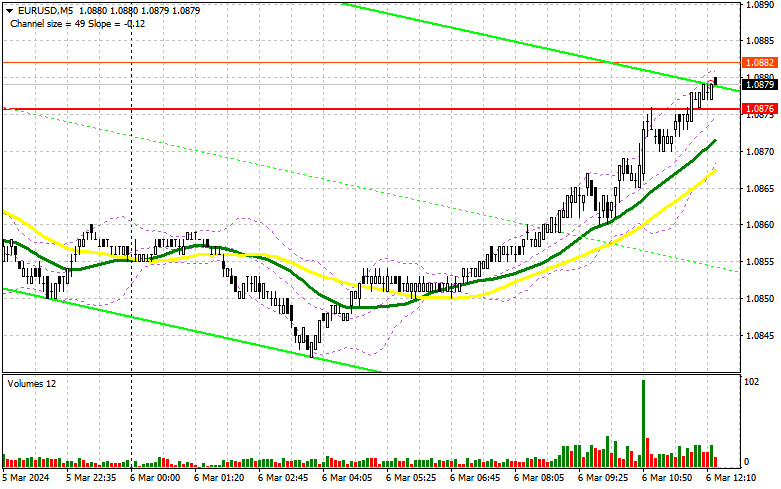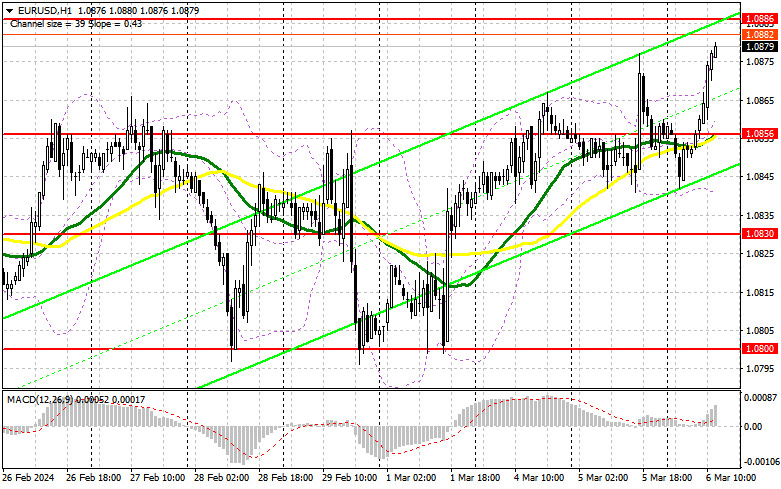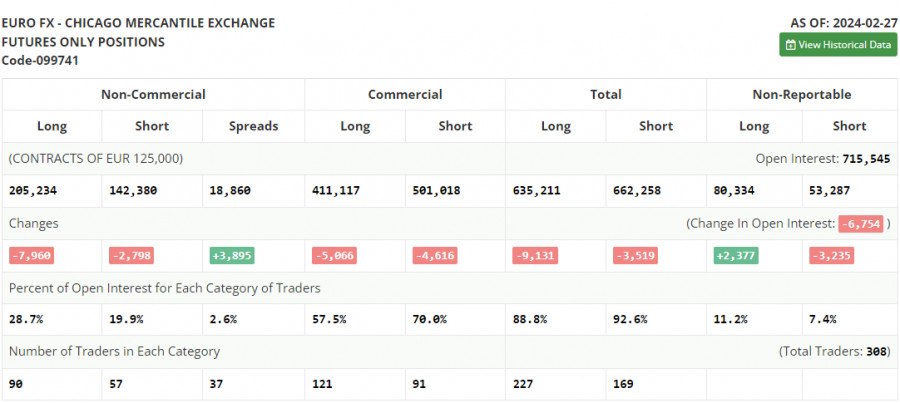
In my morning forecast, I drew attention to the level of 1.0876 and planned to make decisions on market entry based on it. Let's look at the 5-minute chart and analyze what happened there. Growth occurred, but due to the extremely low market volatility, achieving a false breakout and returning below this level for a sell signal was not successful. The technical picture was completely revised for the second half of the day.

To open long positions on EUR/USD, the following is required:
The absence of any reaction to retail sales data in the eurozone for January was quite expected, and now the focus will shift to US data. The change in ADP employment, where a fairly significant increase in the indicator is expected, may once again remind traders that the fight against inflation is not over, strengthening the dollar's position. By the way, this is most likely what Federal Reserve Chairman Jerome Powell will talk about today in his speech to the US Congress. The direction of the pair will depend on his words. In case of a decline in EUR/USD, I will act after the formation of a false breakout near the nearest support at 1.0856, where the moving averages, playing on the bulls' side, intersect. This will provide an entry point into the market with a target for recovery of 1.0886. Breaking and updating the top-down range - another chance to buy with a new high around 1.0905. The ultimate target will be the area of 1.0931, where I will make a profit. In the case of a decline in EUR/USD and the absence of activity at 1.0856, trading will remain within the range of a sideways channel. In this case, I will attempt to enter after the formation of a false breakout near the next support at 1.0830. I plan to enter long positions immediately on a rebound from 1.0800 with the goal of an upward correction of 30-35 points within the day.
To open short positions on EUR/USD, the following is required:
All hopes for sellers are based on strong US data and the hawkish stance of Federal Reserve Chairman Jerome Powell. In the case of the growth of EUR/USD, it is important not to allow the pair to break through the resistance at 1.0886, where the euro is currently heading. Protection and the formation of a false breakout would be a suitable scenario for opening short positions in the development of a downward correction with a target for a decrease to around 1.0856 – the middle of the sideways channel. Only after breaking and consolidating below this range, which may occur during the speeches of US politicians, as well as a bottom-up retest, do I expect to get another entry point for selling with an exit to 1.0830. The ultimate target will be the minimum of 1.0800, where I will take a profit. Testing this level will return the downward trend. In the event of an upward movement of EUR/USD in the second half of the day, as well as the absence of bears at 1.0886, buyers will aim for a new high of 1.0905. I will act there only on a false breakout. I plan to open short positions immediately on a rebound from 1.0931, with the target of a downward correction of 30-35 points.


Indicator Signals:
Moving Averages
Trading is conducted above the 30 and 50-day moving averages, indicating further growth of the euro.
Note: The period and prices of moving averages are considered by the author on the hourly chart H1 and differ from the general definition of classic daily moving averages on the daily chart D1.
Bollinger Bands
In the event of a decline, the lower boundary of the indicator around 1.0840 will act as support.
Description of Indicators
Moving average (which defines the current trend by smoothing volatility and noise). Period 50. Marked on the chart in yellow.Moving Average (which defines the current trend by smoothing volatility and noise). Period 30. Marked on the chart in green.MACD Indicator (Moving Average Convergence/Divergence). Fast EMA period 12. Slow EMA period 26. SMA period 9.Bollinger Bands. Period 20.Non-commercial traders are speculators such as individual traders, hedge funds, and large institutions using the futures market for speculative purposes and meeting certain requirements.Non-commercial long positions represent the total long open positions of non-commercial traders.Non-commercial short positions represent the total short open position of non-commercial traders.The total non-commercial net position is the difference between non-commercial short and long positions.